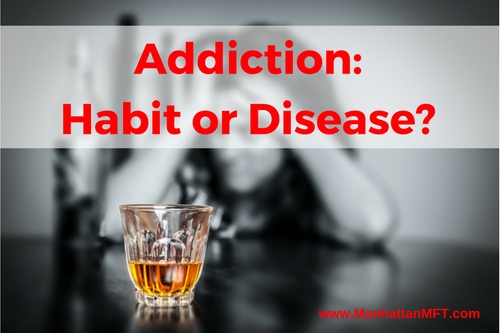|
According to Caron Foundation, 21.6 million people ages 12 and older were classified with substance dependence or abuse in the past year. We can all agree that at the very beginning addiction starts with the first use, often pretty harmless: a drink at a friend’s party, a cupcake after a stressful day, a prescribed painkiller after a surgery, a new exciting app on a smartphone or a video game. What happens after that first use is where addiction individualizes and potentially becomes dangerous. No one intends to get addicted, use every day, hurt their loved ones, need to plan life around using, or give up opportunities for the habit-formed behavior. But it just happens. From Daniel Debiec, MA, CADC, ASAT, CMAT, Caron Foundation: Is addiction a progression of a habit? The American Society of Addiction Medicine Public Policy Statement on Addiction states that genetic factors account for up to fifty percent of the likelihood that an individual will develop the disease. Repeated exposure to mood-altering substances and behaviors leads to neuroadaptation in the brain’s motivational circuitry, which means that even individuals who do not have a genetic predisposition for addiction can change their brain chemistry and, essentially, create an “addicted brain.” Exposure to mood-altering substances and behaviors during adolescence and young adulthood increases the risk of developing the disease of addiction, as the frontal lobes, which are still developing in the adolescent and young adult brain, play an important role in inhibiting impulsivity and assisting in delaying gratification. What is the difference between a habit, a compulsion and addiction? In my opinion, the main difference between a habit and a compulsion/addiction lays in the notion of powerlessness. I believe that a habit can be arrested through the use of the individual will; whereas, a compulsion or addiction will require intervention/support from outside of oneself, including help from medical and psychological professionals, a 12-Step community, and/or a Higher Power. How do you know if your habit is becoming an addiction? One of the hallmarks of addiction that I encourage people to look out for is the continued use of a substance/behavior despite experiencing negative consequences associated with the use of the substance/behavior. Individuals who do not have the disease of addiction are more likely to discontinue their substance use/behavior when they experience a negative consequence. Another thing people should consider when self-assessing for the presence of addiction is where the use of the substance/behavior falls on their priority lists. There is a quote in AA (Alcoholics Anonymous) that says, “a normal drinker adjusts his drinking to fit his life; whereas, the alcoholic adjusts his life to fit his drinking.” As addiction progresses, the pursuit of the substance/behavior moves higher and higher up on the individual’s priority list – eventually becoming the top priority in the sufferer’s life. Where is the line? Due to the insidious nature of the disease of addiction and the self-deception that is most often present in the form of “denial,” it is difficult to delineate where/when a habitual behavior becomes an addiction. The American Society of Addiction Medicine Public Policy Statement on Addiction states that genetic factors account for up to fifty percent of the likelihood that an individual will develop the disease. Repeated exposure to mood-altering substances and behaviors leads to neuroadaptation in the brain’s motivational circuitry, which means that even individuals who do not have a genetic predisposition for addiction can change their brain chemistry and, essentially, create an “addicted brain.” Exposure to mood-altering substances and behaviors during adolescence and young adulthood increases the risk of developing the disease of addiction, as the frontal lobes, which are still developing in the adolescent and young adult brain, play an important role in inhibiting impulsivity and assisting in delaying gratification. The DSM-V outlines 11 criteria that are used to assess whether or not an individual is dealing with a Substance Use Disorder, included in these criteria are experiences such as loss of control, continued use in spite of consequences, craving, tolerance, and withdrawal. Depending on how many of these criteria are met, a qualifier of mild, moderate, or severe will be added to the Substance Use Disorder diagnosis. This is a useful tool for clinicians in assessing the presence and severity of a Substance Use Disorder. No one knows for sure why the same common substances and behaviors can be indulged in by some people and become a problem for others. The progression from the first use to a habit formed to an addiction differs for everyone. How quickly one progresses or not depends on our environment, genetic makeup, neurological chemistry, brain functioning and behavioral patterns. Drugs and alcohol are the obvious habit-forming behaviors or addictions but others include: eating, collecting, prescribed pain killers, video games, smart phone apps, email, shopping, gambling, sex, masturbation and porn. Environmental Factors: Multiple environmental factors influence the development of addiction and are often the reason one starts to form a habit
Mental Health Connection: There is a strong correlation between substance abuse and mental health disorders, which is called ‘dual diagnosis’. When people suffer from anxiety or depression they are more likely to medicate themselves with drugs, alcohol, food, spending, sex, electronics, or hyper-busyness to self-soothe and find temporary relief. Sometimes our excesses are co-signed by a partner with a similar habit, at other times we may isolate, hide from judgement or criticism. Isolation also absolves us of accountability, so we can quietly stay home and use, collect items, web surf, shop, masturbate to porn, etc. Our bad habits grant us a temporary reprieve from the anxiety, depression, or low sense of self-worth. Genetic Factors: Modern genetic research has already identified a number of genes responsible for addictive behaviors. The University of Utah- Genetic Science Center has found connections between certain gene patterns and the progression of addiction. The A1 allele of the dopamine receptor gene DRD2, for example, is more common in people addicted to alcohol or cocaine. Mice with increased expression of the Mpdz gene experience less severe withdrawal symptoms from sedative-hypnotic drugs such as barbiturates, which makes the day after not so bad. Mice mutated with a defective Per2 gene drink three times more alcohol than normal. People with such genetic makeup are more likely to move from problem behaviors to addictive behaviors. And we can see it in our ancestors, parents have similar problems with excess, perhaps they drank to much and we don’t drink but instead of each or shop. It all comes from the same gene pool. The Neuroscience of Addiction As one practices habits, they are creating neurological pathways that, once established, become permanent. Habitual behaviors stimulate the pleasure center of the brain by mimicking the natural chemicals the brain already produces. Soon the habitual behavior will stimulate the feelings of pleasure which will make us behaviorally want to participate again and more often. Once we form a pathway of pleasure from habitual behaviors, we get cravings in the form of thoughts, preoccupations, desires to involve in the habitual behavior. This is how addiction gets its hold on human beings. It is that craving or urge that leads to using again. We hear the peep of email and react by checking it before we even pause to make a conscious decision. The pathway has been developed and the response is automatic. The more one “uses”, the more the brain craves that experience. And, as the tolerance level increases, there is a desire for more and more of the behavior. The increased desire leads to an overpowering effect that makes life unmanageable. How does one change? If the neurological pathways are permanently changed with problem behaviors, how does one recover from an addiction? Dr. Marc Lewis, a developmental neuroscientist, has said in a recent New York Times article that while our “intentions seem to precede our actions, it's often the other way around. We may construct intentions (our sense of being in control) when actions are already underway”. Our amygdala is the emotional memory bank for our past experiences. It remembers our pleasurable and painful experiences, encourages behaviors that bring pleasure and avoidance of experiences that bring pain. It's like an operations manual that tells our minds how to handle stress, how to relax, and how to feel better. To change any behavior, we must create a new pathway and a new operations manual for our brain. We do this by repeating small new replacement behaviors that create the same reward as the old behavior (hint, it’s not the fabulous vodka-fueled dance moves), celebrating our small wins and believing in ourselves. We recognize the urges and cravings but instead of acting on them we do something different until the urge passes (see our free printable 30 Actions to Take Before You Use). In cases of full-blown addiction, it may be impossible and even too dangerous to try to change the behavior by ourselves. Those of us who carry the genes that encourage addiction and have been active for a long time, must not only overcome the habit, they must overcome Mother Nature herself. There are inpatient and outpatient programs that can help by pulling people out of the behavioral pattern and guiding individuals through the process of creating new neural pathways and slowly developing new. Want more information on how to charge your unwanted behavior? Read this blog for more actionable behavior change advice. Comments are closed.
|
Categories
All
Archives
March 2023
|
[email protected]


 RSS Feed
RSS Feed